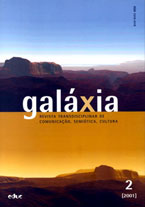<b>Contratos na pintura: o caso de Volpi</b>
Abstract
Tendo como fundamento a semiótica discursiva, discutiremos as estratégias de manipulação empregadas entre um enunciador e um enunciatário, que definem um contrato na pintura. A semiótica ao considerar a pintura como um texto, quando este trata da semelhança com o mundo natural, pressupõe a instalação de um contrato entre enunciador e enunciatário tendo como base um saber do enunciatário sobre o que este considera ser a “realidade” persuadido por um enunciador que o “faz-crer” do “parecido” da pintura com o mundo natural. Realizações deste tipo são chamadas de iconização, que é o “fazer parecer real” assumido pelo nível figurativo de uma obra, não se restringindo, portanto, aos textos imagéticos, mas a todos os textos que produzem efeito de realidade. Palavras-chave semiótica, enunciação, pintura. Abstract Having as base the discursive semiotcs, we shall discuss the strategies of manipulation used between a pronouncer and a speaker that define an agreement in the painting. The semiotics considering the painting as a text when this one treats the likeness with the natural world presuppose the installation of an agreement between a pronouncer and a speaker having as base a knowledge of the speaker about what this one deems to be the persuaded “reality” by a pronouncer that makes him “believe” in the “likeness” of the painting with the natural world. These types of accomplishments are called iconization, that is to “make something look like real”, assumed by the figurative level of a work not restricting, therefore to the texts with icons, but for all the texts that produce a real effect at the painting the creation of effects with a real effect with a real sense. Key words Semiotics, enonciation, painting.Downloads
Published
2007-02-16
How to Cite
Rebouças, M. M. (2007). <b>Contratos na pintura: o caso de Volpi</b>. Galaxia, (2). Retrieved from https://revistas.pucsp.br/index.php/galaxia/article/view/1235
Issue
Section
Artigos | Articles
License
I cede the copyrights to publication of my article to Galaxia journal and will consult the journal’s scientific editor should I decide to republish it later in a book.



 Este obra está licenciada com uma Licença
Este obra está licenciada com uma Licença 